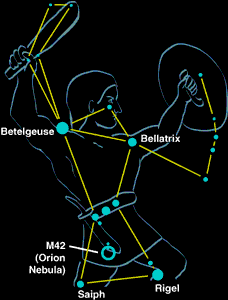For the Northern Hemisphere
March 20 - April 20, 2011
All times are local unless otherwise specified.
Night Sky Visitors ...
My 2011 sabbatical continues. In this abbreviated edition of the Pisces Night Sky, I offer the following to keep you looking up and tuned to the wonders above.
Clear skies,
Susan Sun
Look Up!![]()
Planetary Treats
Universe Today ... Search for any planet; learn the latest!
Star Gazer's Show Scripts highlight planets in the night sky.
Celestial Delights
International Dark Sky Week ~ 4/1-8
How Many Heavenly Rabbits Do You Know?
Scorpius the Rival of Orion
Who Rules Spring?
Plus ...
Sky Lights
Sky Calendars
Moon Dances 3/4-4/3
Moon Dances 4/3-5/3
Aries Navigation Page
The Night Sky ~ Home Page
Planetary Treats
See Sky Lights below for a planetary summary.
The
Planets![]()
Is it
a planet? ... What planet? When you look up at the night sky, how do you
know you are looking at a planet? Learn
what a plutoid is. Click
here.
[ Return to Menu at top ]
Celestial
Delights![]()
![]()
International Dark Sky Week in
2011 occurs Friday - Friday, April 1 - April 8.
This event raises awareness about the importance of preserving a dark sky and
promotes the hobby of astronomy. During this week people are encouraged to
turn out their unnecessary outdoor lights in order to temporarily reduce light
pollution. International
Dark Sky Week is an educational and a take action event.
As cities continue to grow, so does light pollution through poor planning and misuse of outdoor lighting. While light pollution is detrimental to our ability to observe and enjoy the night sky, it also disrupts the surrounding natural environment, wastes energy, and has the potential to cause health problems. Astronomy.com Newsletter 3/19/08
The mission of the International Dark-Sky Association (IDA) is to preserve and protect the nighttime environment from any adverse effect of artificial light. See IDA’s Best Choice Lighting page for resources. Check out Sky and Telescope's Saving Dark Skies for links to helpful, interesting and pertinent articles.
IDA is encouraging everyone to support Earth Hour, which is a global initiative to "turn off the lights" in cities around the world for one hour, starting at 8:30pm local time on Saturday, March 26, 2011. It is intended to bring together a diverse group of community, municipal, corporate and non-governmental organizations, to heighten awareness of the impacts of climate change on the world, and to inspire individuals and businesses to take practical action to reduce their own carbon footprint. Learn more at EarthHour.org.
The value of the night is explored in Ecology Of The Night. National Park scientists on the Night Sky Team work to preserve the Natural Lightscapes, dark night skies above our national parks.
Take action for a dark sky!
[Return to Menu at top]

|

|
For
the legend of the Easter Bunny
and the Rabbit in the Moon click
here.
Find Three Rabbits in the Heavens!
Moon Rabbit as shown above is always seen in the Full Moon.
Lepus The Hare ~ the Cosmic Bunny is located below Orion's feet. He's easier to see in a dark country sky. Use this fun star map for orientation, then compare to this Easter 8:30pm Sky Chart. This cosmic bunny might just have an Easter Egg for you!
Bunny's Footprints belong to a magical bunny and you can track these footprints in Scorpius throughout the year.
[Return to Menu at top]

|
 |
The Myth ~ Scorpius the Rival of Orion
Scorpius is the legendary killer of Orion. Orion was a great hunter who bragged about his skills until the gods grew tired of his boasting. The scorpion was sent to punish Orion, who never thought of such a small creature as a threat. Once he was stung, it was too late. Both were placed in the sky although Orion's last wish was that he never be in the sky as the same time as the scorpion. Thus, Scorpius rules the northern hemisphere's summer while Orion rules the winter skies. StarrySkies.com
Orion
and His Rival
A Fun Cartoon comparing the HUGE red star
in Orion with the HUGE red star in Scorpius. Enjoy!
![]()
Who rules Spring?
Leo the Lion!

Image: StarDate Online / Adobe Photoshop
During Aries as Orion sets in the west and Scorpius rises in the east around midnight, Leo the Lion, as if chasing winter Orion out of the sky, lies overhead as the master of spring. This cosmic Lion rules spring.
Regulus and Leo the Lion Spring Up!
May Spring's Emerging Opportunities Bless you!
[Return to Menu at top]
March 20 - April 20, 2011
Jupiter quickly sinks out of sight, below the western horizon, during the first week of Aries. The planet is in exact conjunction with our Sun 4/6. Jupiter reappears in the morning sky, very low in the east, 30 minutes before sunrise at the end of April. 4/30 Dawn Map
Mercury, reaching its greatest distance from the setting Sun 3/22, gives its best 2011 evening performance. 3/22 7:30pm Map Mercury fades and disappears into the Sun's glowing light during the last week of March. The planet is in exact conjunction with our Sun 4/9. At the end of April use binoculars to spot Mercury in the early morning sky, between Venus and Jupiter. 4/30 Dawn Map ~ Historic First: A Spacecraft Orbits Mercury
Saturn reaches opposition 4/3 and is at its best during Aries, at its closest (800 million miles), biggest and brightest, and out all night long. The Lord of the Rings rises at sunset, lies overhead at midnight and sets at sunrise. The planet's yellowish glow is eye-catching above (west of) bluish Spica. The planet at magnitude 0.4 shines a little brighter than this star. Early April 10pm Map ~ 4/4-7 Star Gazer 5min-Video Use the Big Dipper to locate Saturn (see Arcturus below for details). Saturn's rings are opening, revealing more and more of their northern face. The planet's ring tilt is 9º in April. Saturn brightens and grows bigger as it approaches Earth and its rings open to reflect more light. Generate images of Saturn's ring tilt as seen from Earth with the Solar System Simulator.
Venus at magnitude -3.9 is breathtaking in the morning sky around 6:00am, however it is sinking toward the Sun and is only seen shortly before sunrise. 3/29 - 4/1 the Crescent Moon is elegant near Venus 3/29-3/31 Map ~ 3/31 6am Map ~ 4/1 Map/Text At the end of April several planets line-up with Venus and the Crescent Moon. 4/30 Dawn Map/Text
Mars is too close to our central luminary to be seen. Morning Mars won't be easily seen until mid-May, 30 minutes before sunrise.
Capella is
the very bright star in the northwest setting in the beginning of Aries
at 4:00am and by its end at 2:30am. It is the
brightest star seen the most often. Compare the position of Capella
in these two maps: Winter
Stars (overhead) ~ Spring
Stars (northwest).
The Pleiades star cluster can be seen sinking in the west in the early evening. Look for the line-up, west to southwest, of the sparkling blue-white Pleiades, red Aldebaran and brighter red Betelgeuse. Winter Stars The Pleiades set about 12:15am in the beginning of Aries and by its end at 10:45pm. Springtime Pleiades
Orion The Hunter is found with the winter stars sinking in the southwest at sunset. The stellar giant fully sets in the beginning of Aries by 1:15am and by its end at midnight. Use Orion's stars to navigate this area of the sky. Winter Stars Orion helps one find the Winter Triangle, the Great Winter Hexagon and the Valentine's Star!
Sirius the brightest star in the heavens can be seen high in the south as the sky darkens. Sirius sets in the beginning of Aries around 1:00am and by its end at 11:30pm.
Regulus and Leo the Lion spring up in the east at sunset.
Arcturus, a bright golden star, can be seen low on the eastern horizon at 9:00pm. Use the handle of the Big Dipper to arc down to golden Arcturus, then spike down to blue-white Spica in the south! Helpful Image In 2011 yellowish Saturn, technically at its best 4/3, lies above (west of) bluish Spica. A large triangle is formed by these 3 colorful celestial bodies. Early April 10pm Map Binoculars make vivid their colors. Big Dipper Navigation
[Return to Menu at top]
Monthly
Lunar Highlights
(Currently Offline?!?! ... researching)
![]()
I'd like to know your thoughts about The Night Sky ...
send me an email.
May your Night Sky traveling always be filled
with Celestial Delights and Treats!
Susan Sun
Getting
Started in Astronomy
Includes a downloadable Moon map and bimonthly star charts.
At Skymaps.com download a current monthly guide, evening sky map & calendar.
Link to Sky and Telescope's This Week's Sky at a Glance.
Spaceweather.com keeps you looking up!
Online
Schools
A space and science study guide for kids
[Return to Menu at top]
|
Thank You for Your Heartfelt |
The Night Sky
The Planets
Night Sky Glossary
Aries
Navigation Page
12 Zodiacal Deities
Choosing
a Telescope
Spring
Equinox
Cosmology
~ Highlights
Legendary Journeys of
Hercules
Earthly Delights
Cosmology
Linkups~SouledOut.org's
Recommended Links
Glossary of Esoteric Terms & Phrases
SouledOut.org Site Map
SouledOut.org Home

